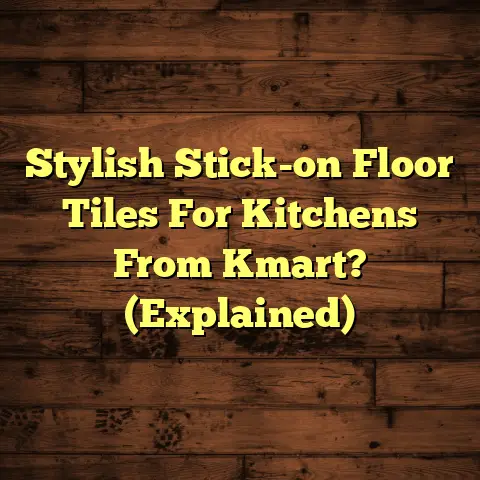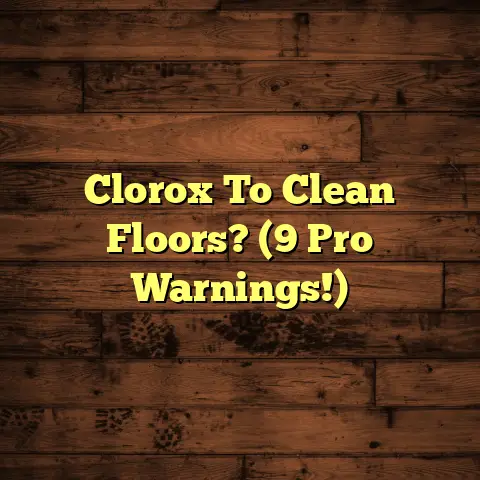Best Hardwood Floor Color? (3 Trends Explode!)
What I haven’t seen fade is the enduring appeal of hardwood. It’s more than just a floor; it’s an investment, a statement, and the foundation upon which you build your home’s aesthetic. And let’s be honest, it adds serious curb appeal and resale value, too.
But with so many options out there, choosing the right hardwood floor color can feel overwhelming. Should you go light and airy? Dark and dramatic? Or something totally unexpected?
That’s what we’re diving into today. We’re going to explore three exploding trends in hardwood floor colors, and I’ll share my insights to help you make the perfect choice for your space. Let’s get started!
1. The Importance of Color in
Hardwood Flooring
Before we jump into the trends, let’s talk about why color matters so much. It’s not just about aesthetics; it’s about how your floor makes you feel and how it impacts the overall ambiance of your home.
1.1. Emotional Impact of Color
Color psychology is a real thing, folks! The colors surrounding us can subtly influence our moods and perceptions. Think about it: bright, sunny yellows make us feel cheerful, while deep blues can evoke a sense of calm and tranquility.
-
Light Colors: These tend to create a sense of openness and airiness. They can make a small room feel larger and more inviting.
-
Dark Colors: On the other hand, dark colors bring a sense of warmth, coziness, and sophistication. They can make a large room feel more intimate.
According to a study published in the Journal of Environmental Psychology, exposure to natural wood tones can even reduce stress levels! So, choosing a hardwood floor color that resonates with you emotionally is crucial.
1.2. Practical Considerations
Okay, enough about feelings! Let’s get practical. The color of your hardwood floor will also affect things like:
-
Light Reflection: Dark floors absorb more light, making a room feel darker. Light floors reflect light, making a room feel brighter.
-
Perception of Space: As we talked about, light floors make a room feel larger, while dark floors can visually shrink a space.
-
Coordination with Decor: Your floor color needs to complement your existing furniture, wall colors, and overall design style. Do you have cool-toned furniture? Warm-toned walls? These are all things to consider.
-
Maintenance: Darker floors tend to show dust and scratches more easily than lighter floors. It’s something to keep in mind if you have pets or kids!
Ultimately, the best hardwood floor color for you will depend on a combination of your personal preferences and the practical realities of your space.
2. Trend 1 – The Rise of Light and
Neutral Tones
Alright, let’s dive into the trends! And first up, is a trend that’s been gaining serious traction: light and neutral tones.
2.1. Overview of Light Wood Trends
Think Scandinavian-inspired blonde oak, bleached maple, and light ash. These light wood colors are popping up everywhere, and for good reason. They perfectly complement modern minimalist and contemporary design trends.
According to the National Wood Flooring Association (NWFA), sales of light-colored hardwood floors have increased by 25% in the past five years. That’s a huge jump!
Why the surge in popularity? I think it’s because light wood floors offer a clean, fresh aesthetic that’s both timeless and versatile.
2.2. Benefits of Light Floors
So, what are the specific benefits of choosing light-colored hardwood floors? Here’s my take:
-
Makes Spaces Feel Larger and Brighter: As we discussed, light colors reflect light, instantly making a room feel more spacious and airy.
-
Timeless Quality: Light wood floors have a classic appeal that transcends fleeting trends. They’re not going out of style anytime soon.
-
Versatility: Light wood floors work well with a wide range of design styles, from modern farmhouse to coastal chic.
-
Hides Imperfections: Light floors tend to camouflage dust, dirt, and minor scratches better than darker floors. This is a big plus for busy households!
-
Easy to Decorate Around: Light wood floors act as a neutral backdrop, allowing you to experiment with bolder furniture and accent colors.
2.3. Case Studies and Examples
Let’s take a look at some real-life examples. I recently worked on a project in a small condo downtown. The space felt cramped and dark. We installed wide-plank, light oak flooring, and the transformation was incredible.
The room instantly felt bigger, brighter, and more inviting. The clients were thrilled!
Another example: I saw a stunning modern farmhouse kitchen featured in House Beautiful magazine. It had light maple floors, white cabinetry, and stainless steel appliances. The overall effect was clean, airy, and incredibly stylish.
Here are some other examples:
-
Scandinavian-style living room: Light ash floors, white walls, and minimalist furniture create a serene and uncluttered space.
-
Coastal-themed bedroom: Bleached oak floors, light blue walls, and natural fiber rugs evoke a relaxed beachy vibe.
-
Modern kitchen: Light maple floors, gray cabinets, and granite countertops create a sleek and contemporary look.
3. Trend 2 – Embracing Rich, Dark Tones
Now, let’s swing to the opposite end of the spectrum: rich, dark tones. While light floors are definitely having a moment, dark hardwood floors are making a serious comeback.
3.1. The Allure of Dark Hardwood Floors
Think deep walnut, rich ebony, and dark-stained oak. These colors evoke sophistication, elegance, and a touch of drama. They work particularly well in traditional and transitional design schemes.
I’ve noticed a growing demand for dark hardwood floors in luxury homes and upscale apartments. There’s just something about that deep, rich color that exudes opulence.
3.2. Advantages of Dark Floors
So, what are the advantages of going dark? Here’s what I’ve observed:
-
Hides Dirt and Scratches (Surprisingly!): While it seems counterintuitive, dark floors can actually hide dirt and scratches better than medium-toned floors. The dark color tends to camouflage imperfections.
-
Adds Depth and Dimension: Dark floors create a sense of depth and dimension in a room. They can make a space feel more grounded and substantial.
-
Creates a Dramatic Effect: There’s no denying that dark floors make a statement. They add a touch of drama and sophistication to any space.
-
Works Well with Bold Colors: Dark floors provide a stunning contrast to bright, bold colors. They can really make your furniture and artwork pop!
-
Adds Warmth and Coziness: In a large room, dark floors can help create a more intimate and cozy atmosphere.
3.3. Design Inspirations
Let’s get inspired! I recently saw a stunning living room featured in Architectural Digest. It had dark walnut floors, cream-colored walls, and plush velvet furniture. The overall effect was luxurious and inviting.
I also worked on a project in a historic Victorian home. We restored the original dark oak floors, and they looked absolutely breathtaking. They added so much character and charm to the space.
Here are some other ideas:
-
Formal dining room: Dark ebony floors, crystal chandelier, and antique furniture create an elegant and sophisticated setting.
-
Home office: Dark walnut floors, leather chairs, and bookshelves create a warm and inviting workspace.
-
Master bedroom: Dark-stained oak floors, plush rugs, and cozy bedding create a luxurious and relaxing retreat.
4. Trend 3 – Bold and Unique Colors
Okay, folks, buckle up! Because this trend is all about pushing the boundaries and making a statement. We’re talking about bold and unique colors in hardwood flooring.
4.1. The Shift Towards Bold Choices
Forget traditional browns and beiges! Homeowners are increasingly embracing bold colors like deep reds, vibrant blues, and even painted finishes. This trend reflects a desire for personalization and unique design statements.
I’ve seen a growing number of clients requesting custom-stained floors in unconventional colors. They want something that truly reflects their personality and style.
4.2. Creative Applications
So, how can you incorporate bold colors into your hardwood flooring? Here are some creative ideas:
-
Accent Boards: Use bold-colored boards as accents within a more neutral floor. This adds a pop of color without overwhelming the space.
-
Painted Finishes: Paint your hardwood floors in a bold color for a truly unique look. This works especially well in eclectic or bohemian-style homes.
-
Mixed Materials: Combine hardwood with other materials, like tile or concrete, in bold colors. This creates a visually interesting and dynamic floor.
-
Geometric Patterns: Use different colored wood stains to create geometric patterns on your floor. This adds a touch of artistry and sophistication.
-
Ombre Effect: Create an ombre effect by gradually transitioning from a light color to a dark color across your floor. This is a subtle but striking way to add visual interest.
4.3. Visual Examples
Let’s take a look at some examples of bold-colored hardwood floors in action:
-
Red Dining Room: A dining room with deep red hardwood floors, gold accents, and velvet chairs creates a lavish and dramatic atmosphere.
-
Blue Living Room: A living room with vibrant blue hardwood floors, white walls, and minimalist furniture creates a modern and artistic space.
-
Green Office: A home office with painted green hardwood floors, wooden shelves, and vintage decor creates a cozy and eclectic workspace.
5. Conclusion: The Future of Hardwood
Floor Colors
We have covered a lot of ground. The key trends we’ve seen are the rise of light and neutral tones, the comeback of rich, dark tones, and the emergence of bold and unique colors.
These trends reflect the evolving nature of interior design and the enduring beauty of hardwood flooring.
I hope this article has given you some inspiration and guidance as you embark on your hardwood flooring journey. Remember, the most important thing is to choose a color that you love and that complements your home’s overall aesthetic.





